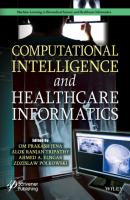Computational Intelligence and Healthcare Informatics. Группа авторов
Чтение книги онлайн.

Читать онлайн книгу Computational Intelligence and Healthcare Informatics - Группа авторов страница 11
Название: Computational Intelligence and Healthcare Informatics
Автор: Группа авторов
Издательство: John Wiley & Sons Limited
Жанр: Программы
isbn: 9781119818694
isbn:
– Chapter 1 is a systematic review of better options in the field of healthcare using machine learning and big data. The use of machine learning (ML) and big data in several application areas in healthcare services are identified which can further improve the unresolved challenges. Technologies such as ML will greatly transform traditional healthcare services and improve the relationship between service users and providers, providing better service in less time. Moreover, ML will help in keeping an eye on critical patients in real time, diagnose their disease, and recommend further treatment.
– Chapter 2 provides a critical analysis of the deep learning techniques utilized for thoracic image analysis and the respective accuracy achieved by it. Various deep learning techniques are described along with dataset, activation function and model used, number and types of layers used, learning rate, training time, epoch, performance metric, hardware used and type of abnormality detected. Moreover, a comparative analysis of existing deep learning models based on accuracy, precision and recall is also presented with an emphasis on the future direction of research.
– Chapter 3 discusses various application domains in need of feature selection techniques and also the way to deal with feature reduction problems occurring in large, voluminous datasets.
– Chapter 4 presents a detailed analysis of the available ML and ANN models conducted vis-à-vis the data considered, and the best one is applied for training and testing the neural networks developed for the present work to detect and predict a disease based on the symptoms described.
– Chapter 5 presents an approach for heart sound classification using the time-frequency image texture feature and support vector machine classifier.
– Chapter 6 proposes a novel approach for selecting a prototype without dropout for the accuracy of the multi-label classification algorithm.
– Chapter 7 introduces an intelligent computational predictive system for the identification and diagnosis of diabetes. Here, eight machine learning classification hypotheses are examined for the identification and diagnosis of diabetes. Numerous performance measuring metrics, such as accuracy, sensitivity, specificity, AUC, F1-score, MCC, and ROC curve, are applied to inspect the effectiveness and stability of the proposed model.
– Chapter 8 proposes hyperparameter optimization for ensemble learners as it has a lot of hyperparameters. The optimized ensemble learning model can be built by tuning the hyperparameters of ensemble learners. This chapter applies a grid search and random search algorithms for tuning the hyper-parameters of ensemble learners. Three ensemble learners are used in this proposed work: two boosting models (AdaBoost and Gradient boosting algorithms) and one bagging model (Random Forest algorithm).
– Chapter 9 presents a detailed analysis of the different types of healthcare simulations—from discrete event simulation (DES) and agent-based methods (ABM) to system dynamics (SD).
– Chapter 10 focuses on the application of Wolfram’s cellular automata (CA) model in different domains of health informatics, medical informatics and bioinformatics. It also reports on the analysis of medical imaging for breast cancer, heart disease, tumor detection and other diseases using CA. Augmenting the machine learning mechanism with CA is also discussed, which provides higher accuracy, precision, security, speed, etc.
– Chapter 11 considers the global dataset of 204 countries for the period of December 31st 2019 to May 19th 2020 from the Worldometer website for study purpose and data from May 20th to June 8th is considered to predict the evaluation of the outbreak, i.e., three weeks ahead. Three of the most prominent data mining techniques—linear regression (LR), association rule mining (ARM) and back propagation neural network (BPNN)—are utilized to predict and analyze the COVID-19 dataset.
– Chapter 12 proposes a hybrid support vector machine (SVM) with chicken swarm optimization (CSO) algorithm for efficient sentiment analysis. Part-of-speech (POS) tagged text is used in this algorithm for extracting the potential features.
– Chapter 13 discusses the primary healthcare model for remote areas using a self-organizing map network.
– Chapter 14 proposes a real-time face mask detection approach using VGG19 from the video stream recorded using a webcam that achieved 100 percent training accuracy with logloss 0.00 and a validation accuracy of 99.63 percent with logloss 0.01 in just 20 epochs.
– Chapter 15 focuses on different types of machine and deep learning algorithms like CNN and SVM for skin disease classification. The methods are very helpful in identifying skin diseases very easily and in fewer time periods.
– Chapter 16 discusses a program developed for collecting heart rhythm, pulse rate, body temperature, and inclination data from patients.
– Chapter 17 describes a proposed automatic COVID-19 detection system that can be used as an alternative diagnostic medium for the virus.
– Chapter 18 presents an innovative approach for deriving interesting patterns using machine learning and graph database models to incorporate the preventive measures in an earlier state. A graph-based statistical analysis (GSA) model to study the COVID-19 pandemic outbreak’s impact is also proposed.
– Chapter 19 discusses the conceptualization of tomorrow’s healthcare through digitization. The objective of this chapter is to utilize the latest resources available at hand to design the case studies.
– Chapter 20 provides a systematic procedure for the development of the POS tagger trained on general domain corpus and the development of biomedical corpus in Hindi.
– Chapter 21 studies the concepts of neuro-linguistic programming (NLP) used in healthcare applications, and also examines the NLP system and the resources which are used in healthcare. СКАЧАТЬ